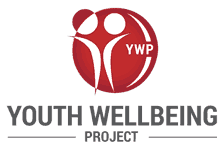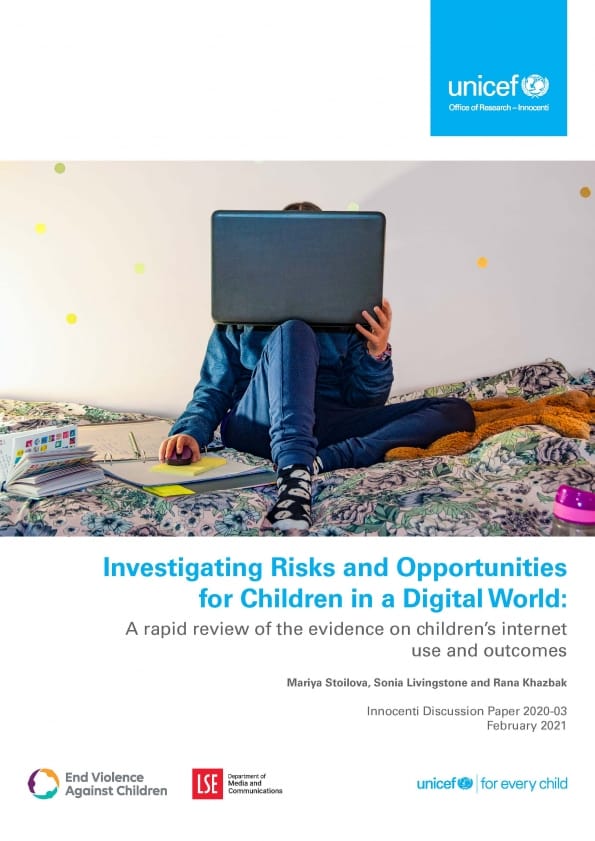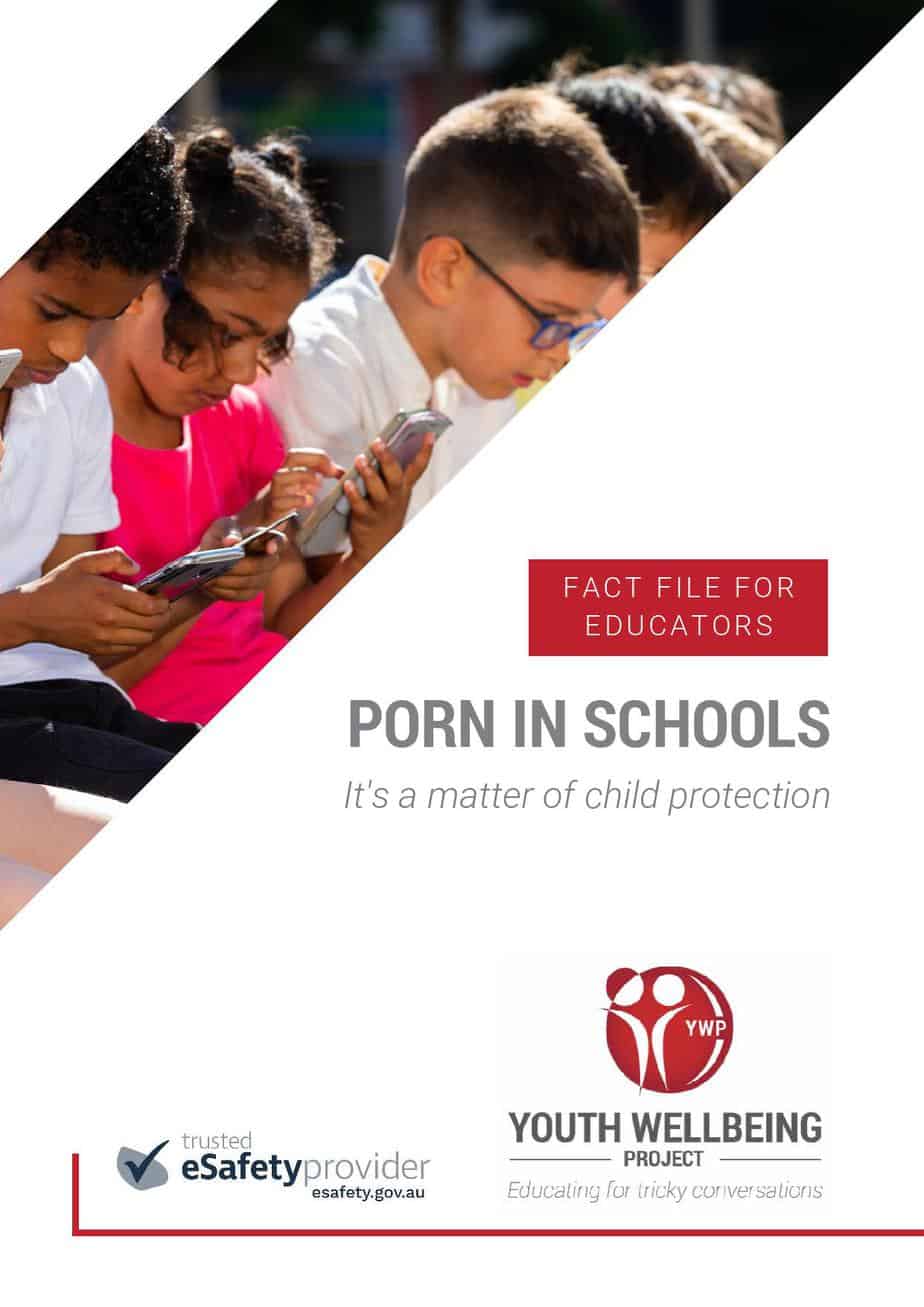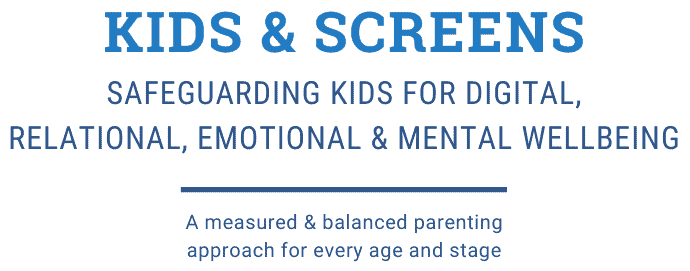On Safer Internet Day (February 9, 2021), UNICEF and LSE launched a rapid evidence review, aiming to identify the pathways to resilience and harm and the factors that can intensify risk or protect children from it. Published as part of our Interesting Studies Feed, the below information is an excerpt from the Global Online Kids research update and authored by Mariya Stoilova and Sonia Livingstone.
Children’s lives are increasingly mediated by digital technologies, yet our knowledge of how this affects their well-being is patchy. Ensuring children’s well-being and positive engagement with digital technologies requires more attention to long-term consequences and filling the gaps in our evidence, regulation, and education initiatives.
Investigating Risks & Opportunities for Children in a Digital World
We know that the digital environment exposes children to new ideas and offers them more diverse sources of information. It can expand their opportunities, reduce inequalities and contribute to realizing their rights. We also know that when children seek information online and want to learn, they risk being exposed to inappropriate or potentially harmful content. But, when it comes to determining the long-term effects of internet use and online experiences on children’s well-being, mental health or resilience, the best we can do is make an educated guess. Does children’s internet use contribute positively to their outcomes? Under what conditions does it amplify the risk of harm and potentially undermine their well-being? Most interestingly, can we identify the pathways to harm and vulnerability, bearing in mind the protective factors that build resilience in children?
This new report shows that online risks are highly unequal in their effects, being more harmful for children who are already disadvantaged offline. The review summarises research published since 2016 about children’s experiences and outcomes relating to the internet and digital technologies, revealing these key findings:
What do we know about pathways to harm and vulnerability?
Vulnerability online and offline
- Children who are vulnerable offline are also more likely to be vulnerable online. They are more exposed to online risk and, in turn, find themselves more likely to experience harm and less able to find support. For example, children with lower levels of happiness or life satisfaction are more likely to be exposed to negative online content, cyber-hate, discrimination or violent extremism. Relatedly, children who experience violence, neglect, physical punishment, psychological victimization, parental conflict, sexual harassment or offline solicitation are more likely to also be exposed to sexual solicitation online.
Who is vulnerable varies
- Not only are some children more vulnerable than others, but who is vulnerable varies with the specific type of online risk. For example, older teenagers, LGBTQI children and those from lower socioeconomic backgrounds are more likely to engage in sexting behaviour and be victims of sextortion. Also, girls are more likely to be victims of online sexual solicitation, coercive sexting and cyber-dating violence. They are also more likely to receive and be asked for sexts from strangers, to have negative sexting experiences, and to be more negatively impacted by cyber-dating violence.
Experiencing multiple online risks
- Children who experience one kind of online risk are also more likely to experience others. For example, online sexual solicitation is associated with exposure to online pornography, posting personal information or pictures online, having contact with unknown people on social media, voluntary sexting, and video chatting with strangers. Cyber-bullying victimization and perpetration is associated with children’s higher exposure to negative online content and to cyber-dating violence. But experiencing a risk does not mean a child is harmed; it could even be beneficial for creating resilience. More evidence is needed on which risks are more harmful than others and what society can do to prevent these.
Connection between offending and victimization
- Importantly too, there is a connection between offending and victimization. Notably, both the victims and perpetrators of cyber-bullying tend to report weaker offline social ties and support from friends and family, higher rates of loneliness, being less liked at school, and lower psychological well-being. Perpetrators of cyber-bullying and sextortion are also more likely to be victims than non-perpetrators. Further, online and offline perpetration and victimization are highly correlated. This suggests that when children become the targets of hurtful behaviour, some hit back, creating a snowball effect of harmful conduct.
While this review usefully summarizes existing evidence, research on how children’s vulnerabilities offline may expose them to harm online is still limited. We need to know more about why, where and how this happens, and what we can do to prevent it.
Protective factors can reduce exposure to online risks and influence how children engage with the online environment. However, there is limited evidence on what these protective factors are, especially in the offline environment, and how they protect children from negative online experiences and harm.
Access the rest of the research update and the full report for more information about this research review and identified protective factors.
Educate to prevent tech and sexualised harms
…online sexual solicitation is associated with exposure to online pornography, posting personal information or pictures online, having contact with unknown people on social media, voluntary sexting, and video chatting with strangers.
It’s often the case that the influence of pornography has not been considered as a risk factor for grooming and exploitation–or posting personal information or pictures online, having contact with unknown people on social media, voluntary sexting, and video chatting with strangers. As such, it’s essential that we consider these broader harms when educating students about pornography.
As a starting point, Youth Wellbeing Project makes the following recommendations:
- Ensure that staff, students and parents are provided with education about the laws related to pornography; students and staff showing other students porn; child sexual exploitation material; and sexual harassment—and the consequence these behaviours carry.
- Develop a safe way for staff, parents and students to report incidents related to porn harms at school. For instance, when peers are watching porn on their phones at school, do students know what to do, or do staff know how to address this?
- When mobile phones are allowed at school, identify what legal risks schools may be subject to when children are harmed by other children showing porn and weaponising this content.
- Pay special attention to policies, practices and procedures for higher-risk children with learning, social or physical disabilities.
- Ensure there’s a clear process for addressing sexual harms, remembering that pornography should not be dismissed as a “boys will be boys” incident, or put in the “too hard basket”. A student who instigates sexual harms should receive follow-up psycho-educational support to understand what is problematic about the behaviour rather than punitive measures such as suspension, and victims must be listened to and offered support.
We invite you to download the Porn in Schools Fact File for Educators for more information to respond to this online mental health and safety risk for children and young people.
Safeguarding: Kids & Screens
Encourage parents to implement a measured and balanced approach to kids and screens. Provide clear messages to parents of primary school children that children should always be supervised online (as recommended by the Australian Centre to Counter Child Exploitation (ACCCE)). Keep in mind that the more portable and internet-connected the device, the more difficult it is to monitor and manage. The Office of the eSafety Commissioner offers great advice to help parents with parental controls, reporting cyberbullying, image-based abuse, or illegal and harmful content (in Australia); and provides many other resources for parents, children and young people, and educators.
New Technologies
Support families to explore new technologies such as G-Mee Connect–a smartphone designed to help children grow capable and responsible in the digital world. G-mee Connect is specially designed for children that are ready for their first smartphone. It gives parents complete control and the ability to restrict and free up functionality when the time is right for their child to have more accessibility. Made by parents for parents to have peace of mind when it comes to giving their child their first device.
Curriculum and whole-school education
Consider how your school is educating to prevent tech & sexualised harms. Youth Wellbeing Project provides IQ PROGRAMS–equipping educators for the task of supporting kids and teens to author their future. Meeting child-safety, developmental and wellbeing needs, teachers receive guided narratives and comprehensive tools to help them deliver tricky conversations confidently. We also provide on-location and online student workshops, professional development and parent seminars–we welcome a booking inquiry for more information.





